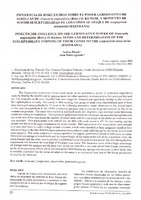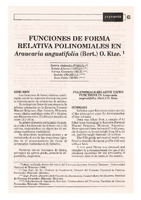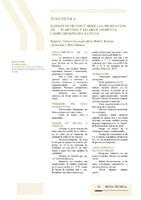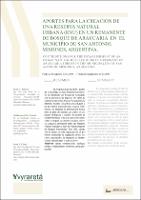Influencia de insecticidas sobre el poder germinativo de semillas de Araucaria augustifolia (Bert.) O. Kuntze, y momento de mayor susceptibilidad de los conos al ataque de Laspeyresia araucariae (pastrana)
Insecticide influence on the germinative power of araucaria angustifolia (bert.) 0. kuntze, seeds and determination of the susceptibility timming of their cones to the laspeyresia araucariae (pastrana)
| dc.creator | Piccoli, Andrea | |
| dc.creator | Agostini, Juan Pedro | |
| dc.date.accessioned | 2022-09-25T16:27:37Z | |
| dc.date.available | 2022-09-25T16:27:37Z | |
| dc.date.issued | 2003-07-01 | |
| dc.identifier.citation | Piccoli, A., y Agostini, J. P. (2003). Influencia de insecticidas sobre el poder germinativo de semillas de Araucaria augustifolia (Bert.) O. Kuntze, y momento de mayor susceptibilidad de los conos al ataque de Laspeyresia araucariae (pastrana). Yvyraretá: Revista Forestal País de Árboles. Eldorado (Misiones): UNaM. FCF; (11), 20-26. | es_AR |
| dc.identifier.issn | 0328-8854 | |
| dc.identifier.other | Yvy-161 | |
| dc.identifier.uri | https://hdl.handle.net/20.500.12219/3696 | |
| dc.description | Fil: Piccoli, Andrea. Universidad Nacional de Misiones. Facultad de Ciencias Forestales; Argentina. | es_AR |
| dc.description | Fil: Agostini, Juan Pedro. Instituto Nacional de Tecnología Agropecuaria. Estación Experimental Agropecuaria Montecarlo (Misiones); Argentina. | es_AR |
| dc.description | Fil: Agostini, Juan Pedro. Universidad Nacional de Misiones. Facultad de Ciencias Forestales; Argentina. | es_AR |
| dc.description.abstract | Larvas de Laspeyresia araucariae provocan daños en el prótalo de semillas de Pino Paraná disminuyendo su poder germinativo y causando la descomposición de la semilla por el ataque de organismos secundarios. En condiciones de laboratorio, semillas de Araucaria fueron clasificadas en: sin daños aparentes y con daños evidentes por la acción de este Lepidóptero. Previo a la siembra de las mismas; cuatro grupos fueron separados y cada uno de ellos sumergidos durante 72 horas en los siguientes tratamientos: agua; dimetoato al 2%0; imidacloprid al 1%o; y mercaptotion al 2 %o del producto comercial de cada agroquímico independientemente, más el agregado de un fungicida sistémico benomyl al 2 %o de producto. Las semillas fueron sembradas en arena esterilizada por vapor en bandejas y mantenidas en condiciones de laboratorio durante todo el experimento. El número de semillas germinadas por cada tratamiento fue registrado a través del tiempo, al igual que el número de semillas en estado de pudrición y altura total de las plantas al final del experimento. Dos experimentos fueron realizados uno luego de dos meses de almacenamiento y el restante luego de nueve meses, aunque en este último fueron incluidas semillas sin tratamiento alguno como control. Paralelamente se seleccionaron desde 50 árboles nativos de Pino Paraná conos de tres tamaños según el tiempo transcurrido desde floración para determinar el número de semillas dañadas por larvas de esta mariposa en cada una de las categorías de cono. Las semillas tratadas con imidacloprid fueron las de más alto poder germinativo tanto en semillas atacadas por la mariposa como en aquellas sin daños; las de menor porcentaje de semillas en estado de pudrición y las plantas con mayor altura final. Las semillas tratadas con otros insecticidas también tuvieron buen porcentaje de germinación durante el primer experimento; aunque las plantas fueron de menor altura; pero en el segundo experimento el porcentaje de germinación alcanzado con esos productos fue muy bajo. Los conos con mayor porcentaje de daños fueron aquellos de tamaño grande y mediano, correspondiente a floraciones de casi dos años, mientras que los mas pequeños de floración del año no manifestaron semillas con daños aparentes; por lo tanto se concluye que el ataque de las larvas de Laspeyresia araucariae son posteriores al periodo de floración como estipula la literatura. | es_AR |
| dc.description.abstract | The Laspeyresia araucariae larvae cause losses on the germinative power of Araucaria angustifolia seeds by feeding the nucella and by opening doors for other secundary microorganisms that produced the seed rot. The Araucaria seeds were classified into two categories: diseased and apparently healthy by the action of the Lephidopthera butterfly. Previously to their seeding, four group of seeds were classified and each of them were sumerged independiently by 72 hours in the following treatments: water; dimetoato at 2%o; imidacloprid at 1%o, and mercaptothion at 2960 of the commercial product, plus a sistemic fungicide benomyl at 2%o of the commercial product. The seeds were seeded in sterilized sandy soil on plastic cups and kept under laboratory conditions during all experiment. The number of germinated seeds per treatment was recorded through the time and at the end of the experiment the number of rotted seeds and the total height of the plants per treatment also was recorded. Two experiments were carried out, the first with seeds stored at 4°C for two months, and the second one stored at the same temperature for seven months. Fifty native trees ofA. angustifolia were selected in a local wild forest to collect a large number of cones, which were classified in three categories based on their size according on the time from bloom to determine the number of seeds with damage by this larvae in each seed cone category. The seeds treated with imidacloprid had the highest germinative power in both types of seeds, the lowest percentage of rotted seeds and the largest height of the plants at the end of the experiment. Also, the seeds treated with the other insecticides had a good behavior in the germination power but only during the first experiment; and however the final high of the plants was lower. The Araucaria cones with a larger percentage of damage were the medium and the large size, which are related to a two year period from bloom, conversely, in the short size cones; which are of one year period from bloom any damage was detected in their seeds; thus it could be concluded that the larvae invasion on the cones is in a period of time later of the bloom season as it is cited by the literature. | en |
| dc.format | application/pdf | |
| dc.format.extent | 2.885 MB | |
| dc.language.iso | spa | es_AR |
| dc.publisher | Universidad Nacional de Misiones. Facultad de Ciencias Forestales. Instituto Subtropical de Investigación Forestales | es_AR |
| dc.relation | info:eu-repo/semantics/altIdentifier/urn/http://www.yvyrareta.com.ar/index.php/component/k2/item/162-insect-araucaria | |
| dc.rights | Atribución-NoComercial-CompartirIgual 4.0 Internacional | |
| dc.rights | info:eu-repo/semantics/openAccess | |
| dc.rights.uri | http://creativecommons.org/licenses/by-nc-sa/4.0/ | |
| dc.subject | Araucaria | es_AR |
| dc.subject | Mariposa del piñón | es_AR |
| dc.subject | Insecticidas | es_AR |
| dc.subject | Poder germinativo | es_AR |
| dc.subject | Laspeyresia | en |
| dc.subject | Insecticides | en |
| dc.subject | Germinative power | en |
| dc.title | Influencia de insecticidas sobre el poder germinativo de semillas de Araucaria augustifolia (Bert.) O. Kuntze, y momento de mayor susceptibilidad de los conos al ataque de Laspeyresia araucariae (pastrana) | es_AR |
| dc.title | Insecticide influence on the germinative power of araucaria angustifolia (bert.) 0. kuntze, seeds and determination of the susceptibility timming of their cones to the laspeyresia araucariae (pastrana) | en |
| dc.type | info:eu-repo/semantics/article | |
| dc.type | info:ar-repo/semantics/artículo | |
| dc.type | info:eu-repo/semantics/publishedVersion |
Files in this item
This item appears in the following Collection(s)
-
Revista Yvyraretá [360]







